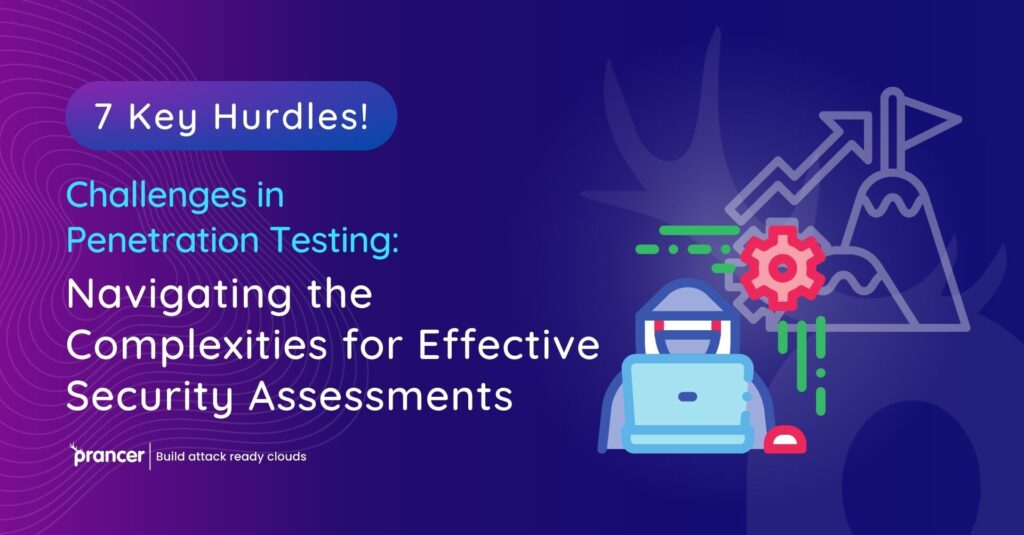

The cybersecurity landscape, both vast and intricate, demands constant vigilance. In the drive to bolster defenses, in-house penetration testing is gaining prominence. Yet, inherent challenges in penetration testing can make or break its effectiveness. This blog shines a spotlight on these challenges and underscores how Prancer’s sophisticated automated penetration testing solutions can be the game-changer. Dive deep with us as we dissect these challenges and reveal how Prancer rises to meet them, ensuring a robust in-house assessment regimen.
In a world where cyber threats morph daily, penetration testers have their work cut out for them. The challenges in penetration testing amplify as they endeavor to emulate real-world attacks. Prancer’s automated penetration testing tools, consistently updated, ensure that the testing mirrors the very latest in attack strategies.
A stark challenge in penetration testing lies in acquiring and retaining internal expertise. Prancer’s intuitive, automated solutions level the playing field, enabling even those with a nascent understanding of tech to conduct rigorous in-house assessments.
Perfectly outlining a penetration test’s breadth and depth is easier said than done. Often, recognizing every conceivable vulnerability becomes a challenge in pen testing. Prancer’s modular and adaptive testing approaches ensure comprehensive coverage.
False positives, while being a common challenge in penetration testing, can lead teams astray and consume critical resources. Prancer’s refined algorithms excel at minimizing such distractions, offering results testers can bank upon.
While detecting vulnerabilities is crucial, the true mettle of a test lies in its aftermath – the remedial actions. One of the subtle challenges in pen testing is ensuring that findings translate into tangible actions. Prancer’s offerings shine yet again, aiding not just in pinpointing vulnerabilities but in the follow-through, ensuring that these gaps are effectively sealed.
In-house penetration testing often treads a fine line, with testers simulating cyberattacks on their own organization. Ensuring that the testing remains ethical and doesn’t inadvertently damage assets is a challenge. Prancer’s automated penetration testing tools come with safeguards to ensure that tests remain within defined ethical parameters.
Despite its importance, penetration testing must often be carried out under tight timelines and resource constraints. Prancer’s automated capabilities expedite the process without compromising on depth or accuracy.
With Prancer’s state-of-the-art automated penetration testing solutions, organizations can confidently address and overcome the challenges in penetration testing. Each challenge, when met head-on with Prancer’s suite, becomes an opportunity to further hone and refine cybersecurity defenses.
Penetration testing must adapt to an ever-changing threat landscape, where cyber threats morph daily. This can be challenging as it requires testers to emulate real-world attacks constantly. However, Prancer’s automated penetration testing tools, which are consistently updated, ensure that the testing mirrors the very latest in attack strategies.
A significant challenge in penetration testing is the acquisition and retention of internal expertise. Prancer’s intuitive, automated solutions level the playing field, enabling even those with a nascent understanding of tech to conduct rigorous in-house assessments.
Scoping precision, or perfectly outlining a penetration test’s breadth and depth, is a complex task. Recognizing every conceivable vulnerability often becomes a challenge. However, Prancer’s modular and adaptive testing approaches ensure comprehensive coverage.
False positives, a common issue in penetration testing, can lead teams astray and consume critical resources. Prancer’s refined algorithms excel at minimizing such distractions, offering results testers can bank upon.
While detecting vulnerabilities is crucial, the true value of a test lies in its aftermath – the remedial actions. One of the subtle challenges in penetration testing is ensuring that findings translate into tangible actions. Prancer’s offerings shine yet again, aiding not just in pinpointing vulnerabilities but in the follow-through, ensuring that these gaps are effectively sealed.
Maintaining ethical boundaries is another challenge faced during in-house penetration testing, as testers simulate cyberattacks on their own organization. Prancer’s automated penetration testing tools come with safeguards to ensure that tests remain within defined ethical parameters.
Despite its importance, penetration testing must often be carried out under tight timelines and resource constraints. Prancer’s automated capabilities expedite the process without compromising on depth or accuracy.
In the hard world of computer protection, in-house security testing is getting more important yet difficult. These problems are about changing to the always different way cyber threats grow, making up for knowledge difference, checking what needs to be done exactly right and fighting wrong high signals. After that we put steps forward based on our findings. Also, keeping fair limits and doing tests within time and resource restraints make things more complicated. But, Prancer’s automatic testing tools give a modern solution to these problems. Using Prancer’s tech, companies can do deep security checks quickly. They don’t need much technical know-how to use it well. Its complex rules lower wrong results and its piece-by-piece setup makes sure all areas are tested well. Prancer helps in fair testing and good use of resources, making it very important for protecting against cyber attacks.
Prancer’s Solutions on Intricate Issues of Internal Penetration Testing.
The Criticality of Proactive Cybersecurity
In the complex and wide cybersecurity world, being proactive is essential. In-house penetration testing has emerged as a formidable ally in the fight against cyber threats. However, underlying challenges during this process can significantly affect its efficiency. This handbook intensely dwells on these issues and demonstrates how Prancer’s advanced automated penetration testing tools can revolutionize such activities.
Penetration Testing Issues and Prancer’s Addresses
Adapting to an Evolving Threat Landscape:
However, the nature of cyber threats is dynamic and so penetration testers need to constently mimic live attacks.
Penetration testing tools developed and maintained by Prancer stay relevant to the latest strategies of attacks, which ensures that it remains effective.
Bridging the Expertise Gap:
One of the biggest challenges in obtaining and retaining skillful people for penetration testing is
Thanks to intuitive, automatic solutions provided by Prancer, the user can perform comprehensive testing regardless of their knowledge level.
Achieving Scoping Precision:
Accurately describing the scope of penetration tests is often problematic because potential vulnerabilities can be manifold and intricate.
Prancer’s testing modes are modular & adaptive, which ensures high coverage to ensure that no vulnerability is missed.
Combatting False Positives:
Misdirected efforts and waste of resources can be caused by false positives.
Prancer’s enhanced algorithms reduce such errors, producing stable outcomes for testers.
Ensuring Actionable Reporting:
Translation of the findings into relevant corrective measures is equally important.
Besides discovering vulnerabilities, Prancer solutions also help in the follow-through that ensures a proper remediation of security holes.
Maintaining Ethical Boundaries:
It is important to ensure ethical practices during the actual in-house penetration testing.
The safeguards incorporated in Prancer’s tools are aimed at preserving ethical testing standards and prevent unintentional asset destruction.
Managing Time and Resource Constraints:
Time and resources are frequently limited in penetration testing.
The automated nature of Prancer simplifies the testing, improving efficiency without sacrificing any detail or values.
Prancer: Turning Penetration Test Challenges into Opportunities
With the help of state-of-the art automated pen test solutions from Prancer, organizations can effectively manage penetration testing challenges. Every challenge created by the suite of tools provided by Prancer becomes an opportunity to improve cybersecurity defenses.
How Prancer Guides Through the Complicated World of Cybersecurity
With the environment of cybersecurity is dynamic, internal penetration testing plays a crucial role for preempting to identify and correct network vulnerabilities. Herein lies the significance of Prancer’s automated penetration testing tools, which effectively address various challenges:
Evolving Threat Landscape: Prancer makes sure that testing strategies are always up to date with the newest cyber threats.
Expertise Gap: It allows more people to have deeper security analysis.
Scoping Challenges: Its adaptive approaches ensure comprehensive coverage of all possible vulnerabilities.
False Positives: The algorithms used for Prancer are tuned down to minimize errors, helping the users focus on real security loopholes.
Actionable Insights: After detection, Prancer helps to perform the practical application of findings thus ensuring remediation.
Ethical Testing: Ethical standards are followed by Prancer’s tools, which guarantees that any undesirable results in testing would arise from deliberate acts.
Resource Efficiency: It is admirable how Prancer manages the time and resource limitations through its efficient automated processes.
Conclusion: Prancer as an Irreplaceable Cybersecurity Partner
Overall, in-house penetration testing as an integral part of effective cybersecurity strategies becomes more prominent despite serious challenges. Through its state-of-the art automated penetration testing solutions, Prancer addresses these issues efficiently and is an indispensable companion in the battle for strong information security. These tools not only improved penetration testing accuracy and efficiency but also ensure that these efforts are conducted ethically in a way which leads to actionable outcomes. With cyber threats in the dynamic nature, implementing Prancer as a tool will be critical for an organization that wants to keep on building a powerful and progressive defense position online.
The challenges in automated penetration testing are significant but not insurmountable, especially when equipped with Prancer’s potent tools. Adopting an in-house approach, backed by Prancer’s capabilities, allows organizations to navigate the complexities of penetration testing, resulting in a fortified cybersecurity stance.
Challenges in penetration testing require a proactive, informed approach. With Prancer‘s automated penetration testing tools tailored to address these challenges, organizations can execute in-depth, accurate assessments with confidence. The synergy of Prancer’s prowess and your in-house expertise positions you to tackle the multifaceted world of cybersecurity.